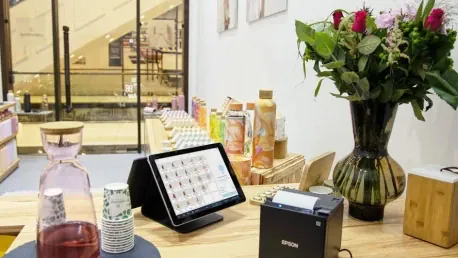In today’s rapidly evolving retail landscape, point-of-sale (POS) systems are undergoing a significant transformation. No longer just static touchpoints, modern POS systems are becoming dynamic, interactive platforms that enhance the customer journey and strengthen brand identity. This article explores how brands can leverage technological advancements to create a seamless omni-experience for consumers, particularly focusing on the demands of Gen Z.
Integration of Technology and POS Systems
The Role of Technology in Modern POS
In today’s retail environment, technology plays a crucial role in modern Point of Sale (POS) systems. These systems have evolved from simple cash registers to sophisticated terminals capable of handling a wide range of functions beyond just processing transactions. By integrating inventory management, customer relationship management (CRM), and analytics, modern POS systems provide retailers with the tools to streamline operations, improve customer service, and make data-driven decisions. Additionally, the adoption of cloud-based POS solutions has enhanced accessibility and scalability, allowing businesses to manage multiple locations with ease.
The integration of technology into POS systems is reshaping the retail experience. Advanced technologies such as artificial intelligence (AI), machine learning, and the Internet of Things (IoT) are being utilized to create more interactive and personalized customer interactions. These technologies enable POS systems to offer tailored recommendations, streamline transactions, and provide real-time inventory updates, enhancing the overall shopping experience. For instance, AI-driven algorithms can analyze purchase history and preferences to suggest products that customers are more likely to buy, thus increasing the chances of sales.
Moreover, IoT devices connected within a retail environment can offer valuable insights into customer behavior, helping brands optimize store layouts, manage inventory more effectively, and deliver a seamless experience. These technologies ensure that POS systems are not merely transactional terminals but become integral parts of an enhanced, efficient, and enjoyable shopping journey. Brands are also using technology to allow contactless payments, mobile wallets, and other innovative payment methods, providing convenience and speed, which are highly valued by modern consumers.
Personalized Customer Interactions
Personalization is a key component of modern POS systems. By leveraging AI, brands can analyze customer data to offer personalized product recommendations and promotions. This not only improves customer satisfaction but also increases the likelihood of repeat purchases. Personalized interactions at the POS can make customers feel valued and understood, fostering brand loyalty. For instance, loyalty programs integrated with POS systems can track customer purchases and preferences, offering rewards and discounts tailored to their buying habits, making them feel appreciated.
In addition, personalized POS interactions can also involve the customization of products or services based on individual preferences. For instance, allowing customers to build their own product bundles or select custom configurations directly at the POS can enhance their shopping experience. It’s a way to cater to the unique tastes and needs of each customer, thus strengthening their connection to the brand. As personalization becomes more sophisticated, it enables brands to create memorable and impactful experiences, turning first-time buyers into loyal customers.
Enhancing Brand Identity
Modern POS systems also play a crucial role in reinforcing brand identity. Interactive screens and digital displays can be used to communicate brand values, stories, and unique selling propositions (USPs). This helps create a cohesive brand experience across all touchpoints, both digital and physical, making the brand more memorable and engaging for consumers. For example, digital displays at POS can showcase short videos about the brand’s heritage, sustainability efforts, or innovative product features, effectively conveying the brand’s message while the customer makes a purchase.
Additionally, brands can use their POS systems to gather feedback and insights from customers, which can then be used to refine and enhance the brand’s offerings and communications. By making the POS a point of engagement rather than merely a point of transaction, brands can deepen their connection with customers. This approach can transform routine purchases into meaningful brand interactions, fostering a sense of loyalty and emotional attachment. The ultimate goal is to ensure that every encounter a customer has with the brand, whether online or offline, contributes to a unified and powerful brand narrative.
Omni-Experience Approach
From Omnichannel to Omni-Experience
The shift from an omnichannel approach to an omni-experience strategy is essential for modern retail. While omnichannel focuses on having a presence across multiple channels, omni-experience emphasizes the quality and purpose of each interaction. Brands need to ensure that every touchpoint, whether online or in-store, provides a seamless and intentional experience that meets the needs of the consumer. This involves understanding the customer’s journey and ensuring that transitions between different channels are smooth and intuitive.
For instance, a customer might start their shopping experience on a brand’s mobile app, continue their research on a website, and eventually complete the purchase in-store. An omni-experience approach ensures that this journey is cohesive and uninterrupted, with each channel offering contextually relevant information and support. It’s about creating a brand ecosystem where every interaction feels connected and purposeful. Brands that succeed in this aspect can foster deeper customer engagement and drive higher customer satisfaction and loyalty.
Seamless Customer Journey
A seamless customer journey is critical in today’s retail environment. Consumers, especially Gen Z, expect a smooth transition between digital and physical experiences. This means that the in-store experience should complement the online experience and vice versa. For example, customers should be able to start a purchase online and complete it in-store without any friction. Retailers can implement features like click-and-collect services, where customers order online and pick up their purchases in-store, merging the convenience of online shopping with the immediacy of physical stores.
Moreover, POS systems should be capable of managing and recalling customer data across channels to provide continuity. A customer’s shopping cart, preferences, and transaction history should be accessible whether they are buying online or in a physical store. Such integration ensures that customers do not have to repeat themselves or start their shopping journey from scratch when switching channels, contributing to a more enjoyable and efficient shopping experience. This level of convenience can significantly impact a consumer’s perception of the brand, making them more likely to return.
Utilizing the Right Channels
An effective omni-experience strategy involves using the right channel for the right experience at the right time. Brands need to understand where their customers are and how they prefer to interact with the brand. This requires a deep understanding of customer behavior and preferences, which can be achieved through data analytics and customer feedback. For instance, young consumers might prefer engaging with brands via social media and mobile apps, while older customers might favor email or in-store interactions.
To cater to these varying preferences, brands must diversify their presence and ensure each channel is optimized for its audience. For example, interactive kiosks in stores can provide self-service options for tech-savvy customers, while knowledgeable sales associates offer personalized assistance to those who prefer human interaction. By strategically leveraging each channel’s strengths, brands can create a more dynamic and engaging customer experience. The ultimate aim is to meet customers where they are and deliver value in a way that resonates most with them, thereby enhancing their overall experience and satisfaction.
Personalization and Engagement
Leveraging AI for Personalization
Leveraging AI for personalization has become a significant trend in various industries, offering customized experiences and recommendations based on individual preferences and behaviors. By analyzing vast amounts of data, AI algorithms can identify patterns and make predictions, enabling businesses to tailor their offerings to meet the specific needs and desires of each customer. This level of personalization not only enhances customer satisfaction but also drives engagement and loyalty, ultimately boosting sales and revenue. As AI technology continues to advance, its applications in personalization are expected to become even more sophisticated and effective, transforming the way businesses interact with their customers.
AI is a powerful tool for personalizing the customer experience at the POS. By analyzing customer data, AI can provide personalized product recommendations, promotions, and even customized shopping experiences. This level of personalization can significantly enhance customer satisfaction and drive loyalty. For example, AI algorithms can track purchasing patterns and suggest products that align with the customer’s tastes and needs, making the shopping experience more relevant and enjoyable.
Additionally, AI can be used to create personalized marketing campaigns and tailor advertisements that reflect individual customer preferences. This not only makes the marketing efforts more effective but also fosters a sense of familiarity and connection for the customer. Brands that successfully incorporate AI into their POS systems can offer a highly individualized shopping experience, which can set them apart from competitors. Personalized greetings, tailored suggestions, and targeted loyalty rewards are just a few examples of how AI can elevate the customer experience.
Interactive and Engaging POS
Interactive elements such as touchscreens, digital displays, and gamification can make the POS experience more engaging and enjoyable. These features can capture the attention of customers and create a memorable shopping experience. For example, interactive screens can be used to showcase product information, offer virtual try-ons, or provide entertainment while customers wait in line. These interactive tools can also facilitate product comparisons and provide detailed information that enhances the decision-making process.
Furthermore, gamification elements, like in-store challenges or rewards for completing certain activities, can create a fun and interactive environment for customers. This not only makes the shopping experience more enjoyable but also encourages customers to spend more time engaging with the products and the brand. By making the POS a point of engagement, brands can transform routine purchases into exciting experiences, fostering a deeper connection with their customers. These strategies help in building a loyal customer base that looks forward to shopping with the brand.
Gamification and Immersive Experiences
Gamification is another effective way to engage customers at the POS. By incorporating game-like elements such as rewards, challenges, and leaderboards, brands can create a fun and interactive shopping experience. Immersive experiences, such as augmented reality (AR) and virtual reality (VR), can also be used to enhance the POS experience, allowing customers to interact with products in new and exciting ways. For example, AR mirrors can enable customers to virtually try on clothing or accessories, providing a unique and engaging shopping experience without the need for physical trials.
Moreover, VR setups can transport customers to a different environment where they can explore products and services in an immersive, engaging manner. These innovative approaches not only capture customer interest but also provide valuable information that can help in the final purchasing decision. Gamification and immersive technologies create an intriguing and enjoyable shopping experience, encouraging customers to return and explore more. They also allow brands to differentiate themselves by offering unique and memorable interactions that stand out in the competitive retail landscape.
Blending Physical and Digital Elements
Complementing Traditional Shopping with Digital Tools
Blending physical and digital elements is key to creating a seamless omni-experience. Traditional in-store elements such as product displays and customer service can be enhanced with digital tools like mobile apps, QR codes, and digital signage. This creates a cohesive and integrated shopping experience that meets the needs of modern consumers. For instance, QR codes on product tags can provide instant access to detailed information or customer reviews, enhancing transparency and helping customers make informed decisions.
Furthermore, integrating mobile apps with in-store experiences can enable features such as scanning products for additional details, locating items within the store, or receiving instant notifications about in-store promotions. These digital tools not only support convenience and efficiency but also create a more engaging shopping environment. By blending these elements, brands can ensure that customers receive a unified experience whether they are browsing products in-store or interacting through digital platforms.
Enhancing In-Store Experience with Digital Integration
By combining traditional retail environments with innovative digital tools, businesses can significantly improve the customer experience. Interactive displays, self-service kiosks, and mobile apps are just a few of the ways that retailers are bridging the gap between physical stores and online shopping. This seamless integration allows customers to enjoy the convenience of digital technology while still benefiting from the tangible aspects of in-store shopping. The use of data analytics also helps retailers better understand customer preferences and tailor their offerings accordingly, leading to increased satisfaction and loyalty. Through these efforts, stores not only enhance the shopping experience but also drive higher sales and build stronger customer relationships.
Digital integration can significantly enhance the in-store experience. For example, digital kiosks can provide product information, allow customers to place orders, and even offer personalized recommendations. Mobile apps can be used to facilitate in-store navigation, provide exclusive offers, and enable contactless payments. These digital tools can make the in-store experience more convenient and enjoyable for customers. For instance, interactive kiosks can act as virtual sales assistants, providing instant help and guidance without the need for physical staff.
Moreover, digital signage can dynamically update to reflect real-time promotions, product availability, and brand messages, keeping customers informed and engaged. Contactless payment options further streamline the checkout process, reducing wait times and enhancing customer satisfaction. By integrating these digital solutions, brands can create a modern, efficient, and pleasurable shopping environment that aligns with the expectations of today’s tech-savvy consumers. This approach not only enhances the shopping experience but also boosts operational efficiency, making it a win-win for both customers and retailers.
Creating a Cohesive Brand Experience
A cohesive brand experience is essential for maintaining customer loyalty and trust. Through consistent messaging, visual identity, and user interactions, a brand can effectively communicate its values and mission to its audience. This unified approach not only strengthens the brand’s presence but also enhances customer satisfaction and engagement across multiple touchpoints.
A cohesive brand experience is essential for building strong customer relationships. By integrating digital and physical elements, brands can create a consistent and unified experience across all touchpoints. This helps reinforce brand identity and ensures that customers have a positive and memorable interaction with the brand, whether they are shopping online or in-store. For example, the same brand aesthetics, messaging, and values should be evident in both digital interfaces and physical store environments.
Additionally, seamless integration means that customers can effortlessly transition between different points of interaction with the brand, without encountering any disruption or inconsistency. This unity fosters trust and loyalty, as customers know they can expect the same quality and service regardless of the channel they choose. Brands that master the art of blending these elements can create a powerful and cohesive narrative that resonates with consumers, enhancing brand loyalty and encouraging repeat business.
Storytelling and Brand Identity
Extending Brand Storytelling through Digital POS
Digitalized POS systems provide an excellent platform for extending brand storytelling. Brands can use digital displays and interactive elements at the POS to communicate their values, history, and unique selling propositions (USPs) effectively. This allows customers to engage with the brand on a deeper level, exploring the stories behind the products and the company’s mission. For instance, video displays can showcase the brand’s commitment to sustainability or highlight the craftsmanship involved in creating their products, making the shopping experience more meaningful.
Furthermore, storytelling through digital POS can also involve featuring customer testimonials and user-generated content, creating a community feel and encouraging customers to be part of the brand’s journey. This interactive engagement not only enhances the shopping experience but also fosters a stronger emotional connection between the brand and the customers. By leveraging digital POS for storytelling, brands can ensure that each customer interaction conveys a consistent and compelling narrative that strengthens brand identity and loyalty.
Building Trust and Engagement through Storytelling
Using storytelling to build trust and engagement at the point of sale can significantly elevate the customer experience. By sharing authentic stories about the brand’s origins, philosophy, and impact, brands can create an emotional bond with customers. This connection is particularly important for Gen Z consumers, who often prioritize authenticity and values when choosing brands. For example, illustrating the brand’s journey, highlighting ethical practices, or demonstrating social contributions can resonate deeply with these consumers.
Moreover, digital POS tools can facilitate real-time engagement and feedback, creating a dialogue between the brand and its customers. Interactive screens can prompt customers to share their own experiences, participate in polls, or provide instant feedback, making them feel more involved and valued. This two-way interaction not only enhances the shopping experience but also provides valuable insights for brands to continuously improve and innovate. Storytelling through digital POS thus becomes a powerful tool to build trust, enhance engagement, and cultivate a loyal customer base.
Conclusion
The retail landscape is rapidly evolving, and today’s point-of-sale (POS) systems are undergoing notable transformations. Once mere static touchpoints, modern POS systems are now dynamic, interactive platforms that play a crucial role in enhancing the customer experience and reinforcing brand identity. This shift is particularly relevant in meeting the expectations of Gen Z, who prioritize seamless shopping experiences and are keen on technology integration. By leveraging the latest technological advancements, brands can create a cohesive omni-experience for consumers, blending online and offline interactions. This article delves into the ways retail businesses can harness these technologies to stay competitive and meet the ever-changing demands of their customer base. Modern POS systems are no longer just about processing transactions; they’re about creating an engaging and personalized journey for the customer. In this context, brands must focus on innovation to provide a shopping experience that is not only efficient but also memorable, ensuring consumer loyalty and satisfaction.









